brake light YAMAHA TRICITY 2017 Owners Manual
[x] Cancel search | Manufacturer: YAMAHA, Model Year: 2017, Model line: TRICITY, Model: YAMAHA TRICITY 2017Pages: 92, PDF Size: 3.43 MB
Page 5 of 92
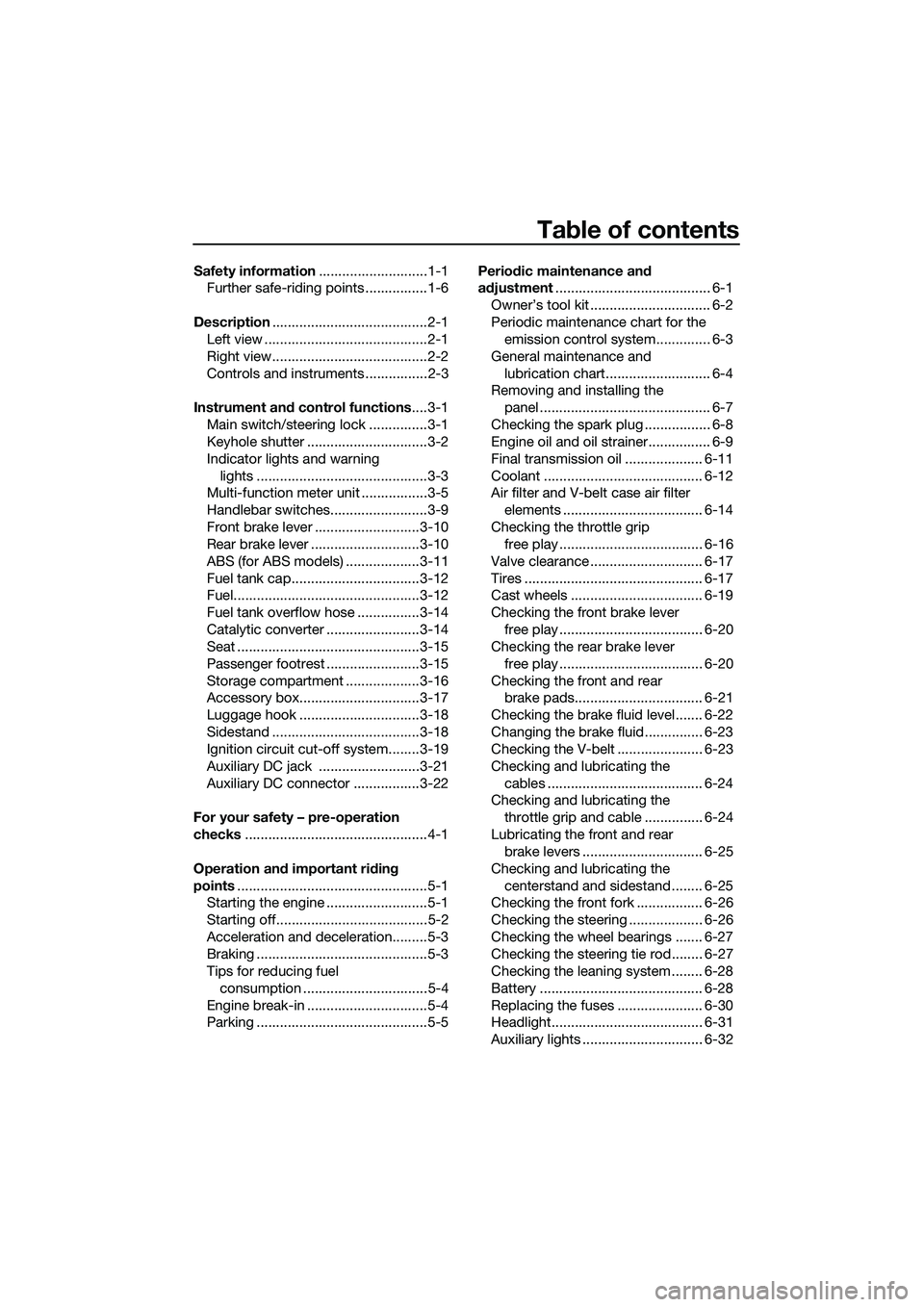
Table of contents
Safety information............................1-1
Further safe-riding points ................1-6
Description........................................2-1
Left view ..........................................2-1
Right view........................................2-2
Controls and instruments ................2-3
Instrument and control functions....3-1
Main switch/steering lock ...............3-1
Keyhole shutter ...............................3-2
Indicator lights and warning
lights ............................................3-3
Multi-function meter unit .................3-5
Handlebar switches.........................3-9
Front brake lever ...........................3-10
Rear brake lever ............................3-10
ABS (for ABS models) ...................3-11
Fuel tank cap.................................3-12
Fuel................................................3-12
Fuel tank overflow hose ................3-14
Catalytic converter ........................3-14
Seat ...............................................3-15
Passenger footrest ........................3-15
Storage compartment ...................3-16
Accessory box...............................3-17
Luggage hook ...............................3-18
Sidestand ......................................3-18
Ignition circuit cut-off system........3-19
Auxiliary DC jack ..........................3-21
Auxiliary DC connector .................3-22
For your safety – pre-operation
checks...............................................4-1
Operation and important riding
points.................................................5-1
Starting the engine ..........................5-1
Starting off.......................................5-2
Acceleration and deceleration.........5-3
Braking ............................................5-3
Tips for reducing fuel
consumption ................................5-4
Engine break-in ...............................5-4
Parking ............................................5-5Periodic maintenance and
adjustment........................................ 6-1
Owner’s tool kit ............................... 6-2
Periodic maintenance chart for the
emission control system.............. 6-3
General maintenance and
lubrication chart........................... 6-4
Removing and installing the
panel ............................................ 6-7
Checking the spark plug ................. 6-8
Engine oil and oil strainer................ 6-9
Final transmission oil .................... 6-11
Coolant ......................................... 6-12
Air filter and V-belt case air filter
elements .................................... 6-14
Checking the throttle grip
free play ..................................... 6-16
Valve clearance ............................. 6-17
Tires .............................................. 6-17
Cast wheels .................................. 6-19
Checking the front brake lever
free play ..................................... 6-20
Checking the rear brake lever
free play ..................................... 6-20
Checking the front and rear
brake pads................................. 6-21
Checking the brake fluid level....... 6-22
Changing the brake fluid............... 6-23
Checking the V-belt ...................... 6-23
Checking and lubricating the
cables ........................................ 6-24
Checking and lubricating the
throttle grip and cable ............... 6-24
Lubricating the front and rear
brake levers ............................... 6-25
Checking and lubricating the
centerstand and sidestand ........ 6-25
Checking the front fork ................. 6-26
Checking the steering ................... 6-26
Checking the wheel bearings ....... 6-27
Checking the steering tie rod........ 6-27
Checking the leaning system ........ 6-28
Battery .......................................... 6-28
Replacing the fuses ...................... 6-30
Headlight....................................... 6-31
Auxiliary lights ............................... 6-32
UBR7E0E0.book Page 1 Tuesday, October 25, 2016 2:44 PM
Page 6 of 92
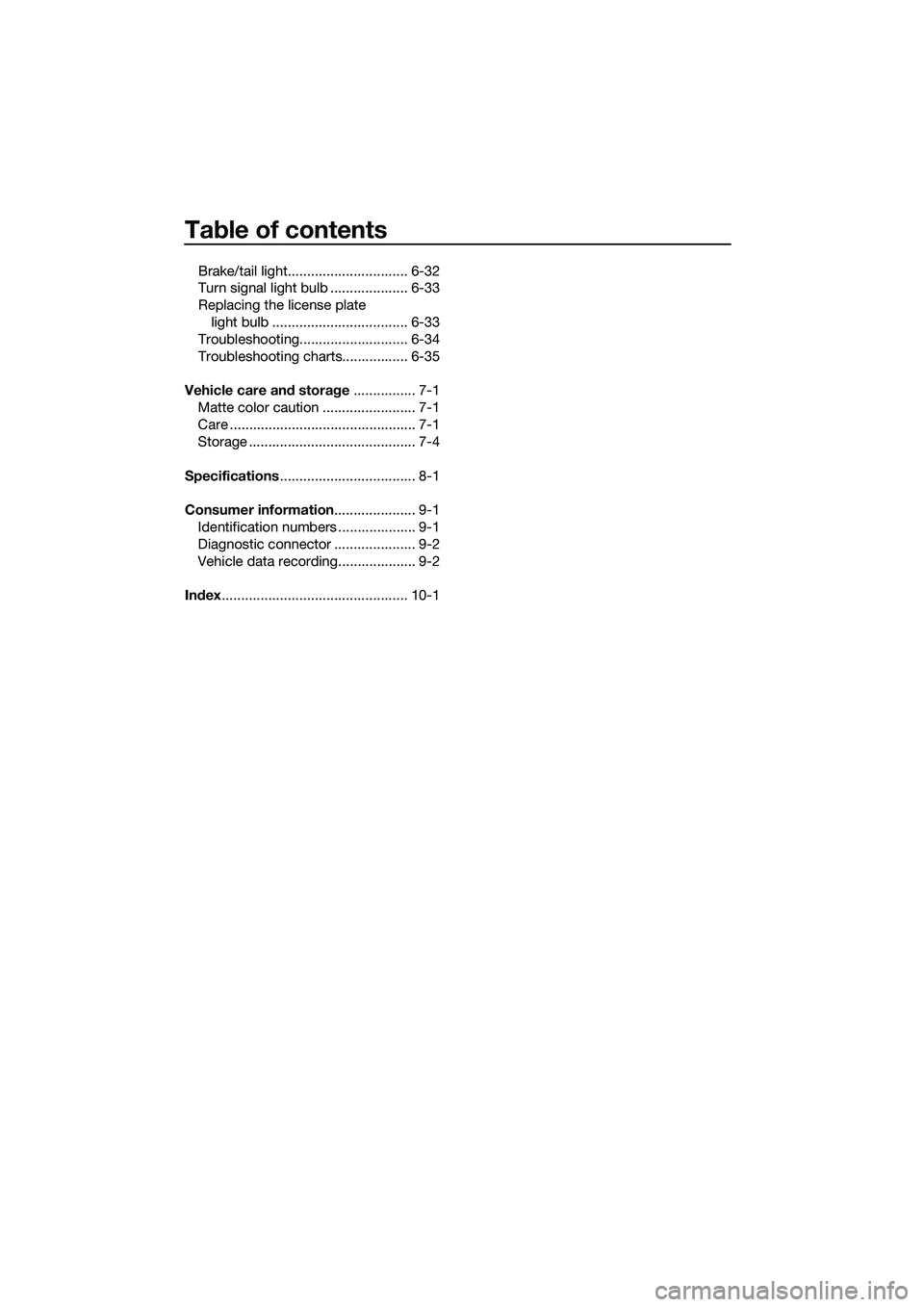
Table of contents
Brake/tail light............................... 6-32
Turn signal light bulb .................... 6-33
Replacing the license plate
light bulb ................................... 6-33
Troubleshooting............................ 6-34
Troubleshooting charts................. 6-35
Vehicle care and storage................ 7-1
Matte color caution ........................ 7-1
Care ................................................ 7-1
Storage ........................................... 7-4
Specifications................................... 8-1
Consumer information..................... 9-1
Identification numbers .................... 9-1
Diagnostic connector ..................... 9-2
Vehicle data recording.................... 9-2
Index................................................ 10-1
UBR7E0E0.book Page 2 Tuesday, October 25, 2016 2:44 PM
Page 17 of 92
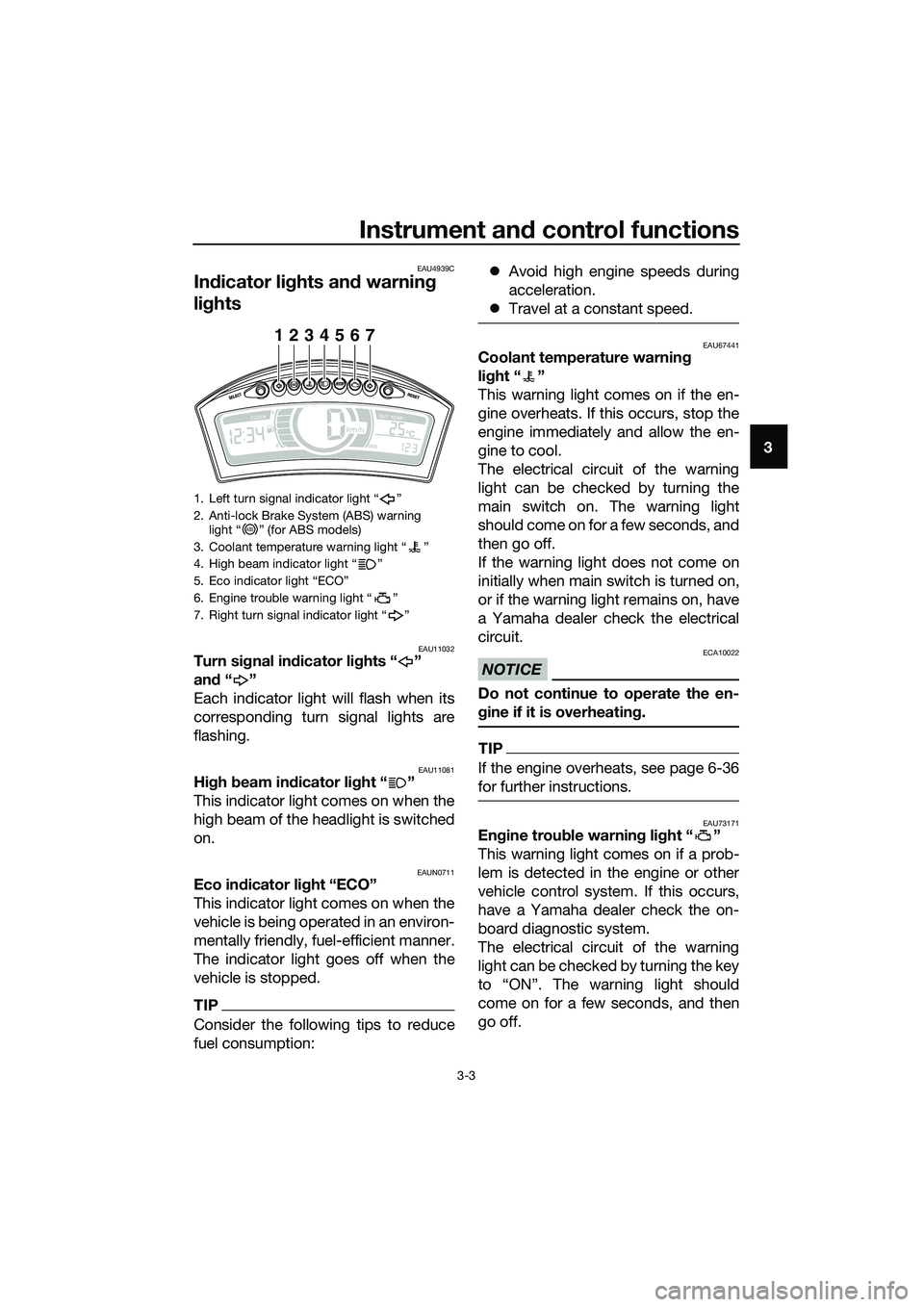
Instrument and control functions
3-3
3
EAU4939C
Indicator lights and warning
lights
EAU11032Turn signal indicator lights “ ”
and“”
Each indicator light will flash when its
corresponding turn signal lights are
flashing.
EAU11081High beam indicator light “ ”
This indicator light comes on when the
high beam of the headlight is switched
on.
EAUN0711Eco indicator light “ECO”
This indicator light comes on when the
vehicle is being operated in an environ-
mentally friendly, fuel-efficient manner.
The indicator light goes off when the
vehicle is stopped.
TIP
Consider the following tips to reduce
fuel consumption:�zAvoid high engine speeds during
acceleration.
�zTravel at a constant speed.
EAU67441Coolant temperature warning
light “ ”
This warning light comes on if the en-
gine overheats. If this occurs, stop the
engine immediately and allow the en-
gine to cool.
The electrical circuit of the warning
light can be checked by turning the
main switch on. The warning light
should come on for a few seconds, and
then go off.
If the warning light does not come on
initially when main switch is turned on,
or if the warning light remains on, have
a Yamaha dealer check the electrical
circuit.
NOTICE
ECA10022
Do not continue to operate the en-
gine if it is overheating.
TIP
If the engine overheats, see page 6-36
for further instructions.
EAU73171Engine trouble warning light “ ”
This warning light comes on if a prob-
lem is detected in the engine or other
vehicle control system. If this occurs,
have a Yamaha dealer check the on-
board diagnostic system.
The electrical circuit of the warning
light can be checked by turning the key
to “ON”. The warning light should
come on for a few seconds, and then
go off.
1. Left turn signal indicator light “ ”
2. Anti-lock Brake System (ABS) warning
light “ ” (for ABS models)
3. Coolant temperature warning light “ ”
4. High beam indicator light “ ”
5. Eco indicator light “ECO”
6. Engine trouble warning light “ ”
7. Right turn signal indicator light “ ”
1234567
ABS
UBR7E0E0.book Page 3 Tuesday, October 25, 2016 2:44 PM
Page 18 of 92
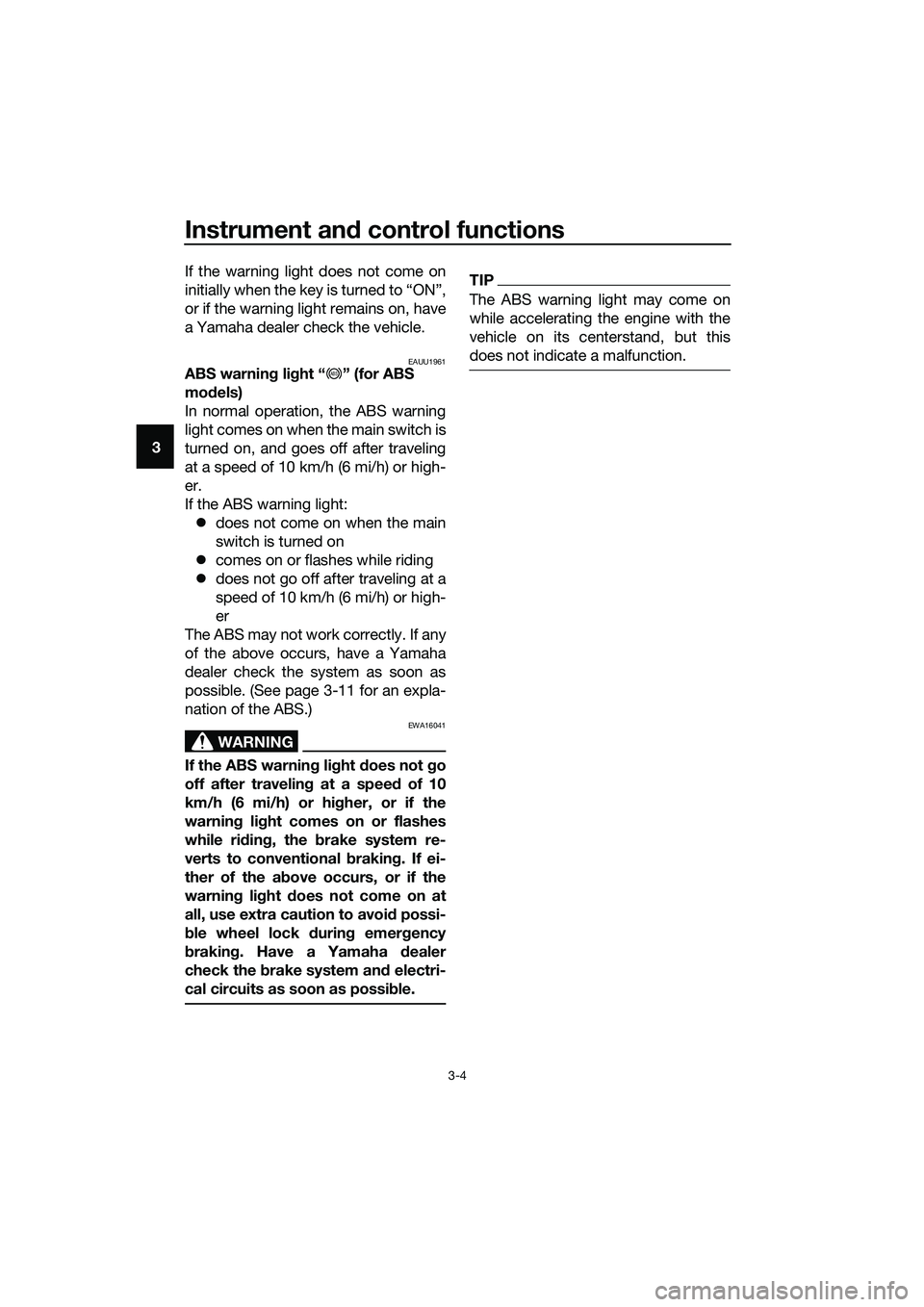
Instrument and control functions
3-4
3If the warning light does not come on
initially when the key is turned to “ON”,
or if the warning light remains on, have
a Yamaha dealer check the vehicle.
EAUU1961ABS warning light “ ” (for ABS
models)
In normal operation, the ABS warning
light comes on when the main switch is
turned on, and goes off after traveling
at a speed of 10 km/h (6 mi/h) or high-
er.
If the ABS warning light:
�zdoes not come on when the main
switch is turned on
�zcomes on or flashes while riding
�zdoes not go off after traveling at a
speed of 10 km/h (6 mi/h) or high-
er
The ABS may not work correctly. If any
of the above occurs, have a Yamaha
dealer check the system as soon as
possible. (See page 3-11 for an expla-
nation of the ABS.)
WARNING
EWA16041
If the ABS warning light does not go
off after traveling at a speed of 10
km/h (6 mi/h) or higher, or if the
warning light comes on or flashes
while riding, the brake system re-
verts to conventional braking. If ei-
ther of the above occurs, or if the
warning light does not come on at
all, use extra caution to avoid possi-
ble wheel lock during emergency
braking. Have a Yamaha dealer
check the brake system and electri-
cal circuits as soon as possible.
TIP
The ABS warning light may come on
while accelerating the engine with the
vehicle on its centerstand, but this
does not indicate a malfunction.
ABS
UBR7E0E0.book Page 4 Tuesday, October 25, 2016 2:44 PM
Page 23 of 92
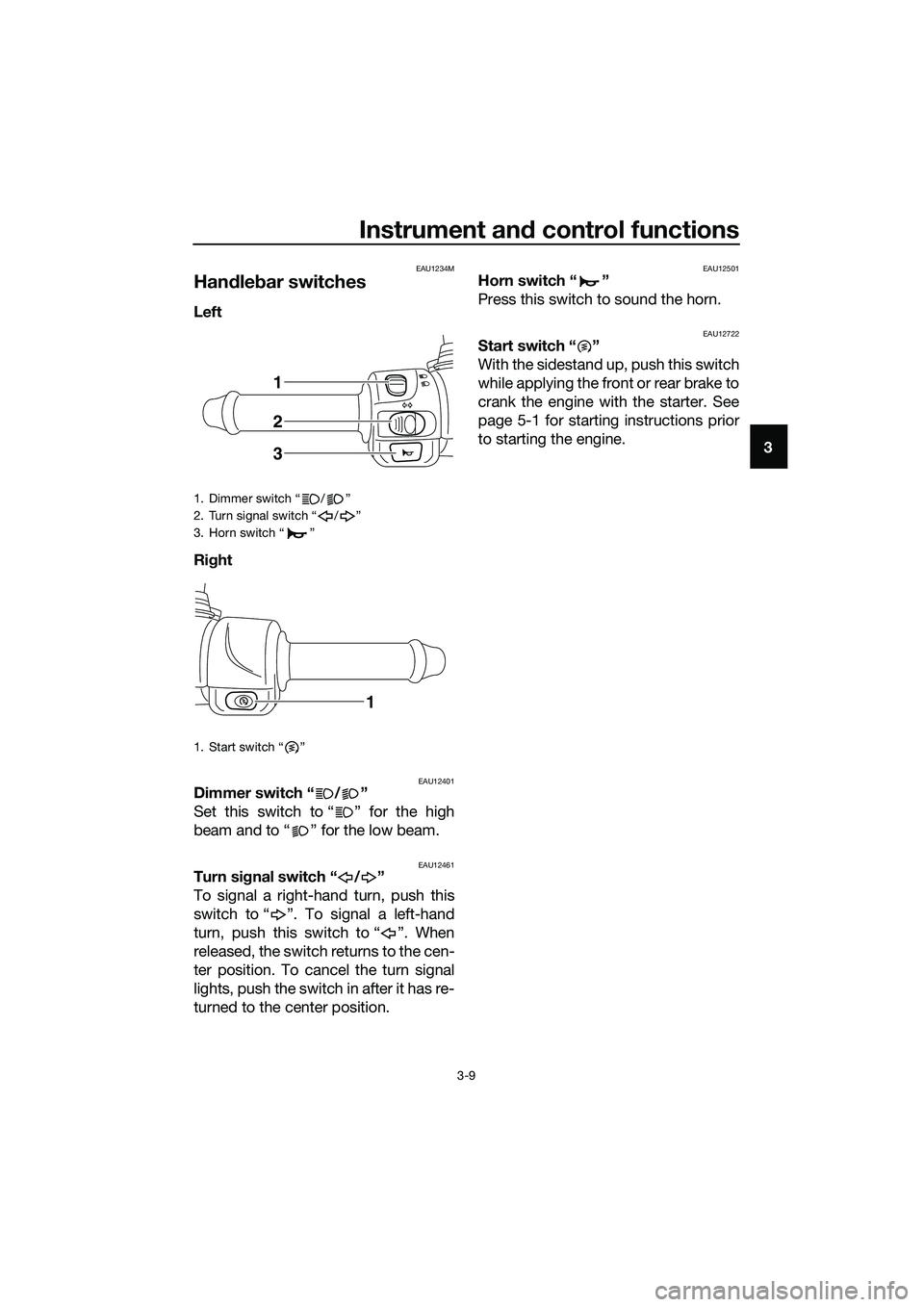
Instrument and control functions
3-9
3
EAU1234M
Handlebar switches
Left
Right
EAU12401Dimmer switch “ / ”
Set this switch to “ ” for the high
beam and to “ ” for the low beam.
EAU12461Turn signal switch “ / ”
To signal a right-hand turn, push this
switch to “ ”. To signal a left-hand
turn, push this switch to “ ”. When
released, the switch returns to the cen-
ter position. To cancel the turn signal
lights, push the switch in after it has re-
turned to the center position.
EAU12501Horn switch “ ”
Press this switch to sound the horn.
EAU12722Start switch “ ”
With the sidestand up, push this switch
while applying the front or rear brake to
crank the engine with the starter. See
page 5-1 for starting instructions prior
to starting the engine.
1. Dimmer switch “ / ”
2. Turn signal switch “ / ”
3. Horn switch “ ”
1. Start switch “ ”
1
2
3
1
UBR7E0E0.book Page 9 Tuesday, October 25, 2016 2:44 PM
Page 25 of 92
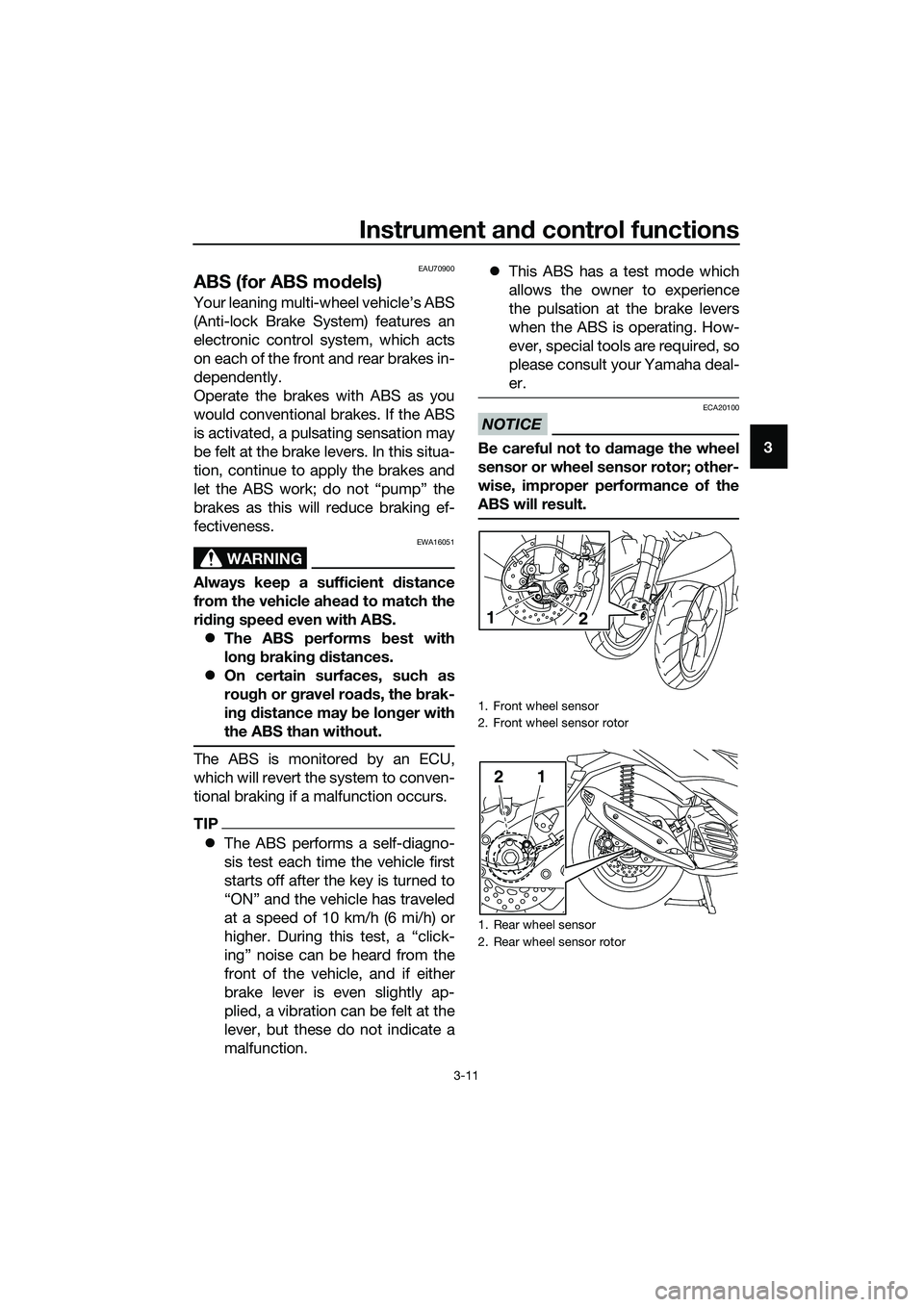
Instrument and control functions
3-11
3
EAU70900
ABS (for ABS models)
Your leaning multi-wheel vehicle’s ABS
(Anti-lock Brake System) features an
electronic control system, which acts
on each of the front and rear brakes in-
dependently.
Operate the brakes with ABS as you
would conventional brakes. If the ABS
is activated, a pulsating sensation may
be felt at the brake levers. In this situa-
tion, continue to apply the brakes and
let the ABS work; do not “pump” the
brakes as this will reduce braking ef-
fectiveness.
WARNING
EWA16051
Always keep a sufficient distance
from the vehicle ahead to match the
riding speed even with ABS.
�zThe ABS performs best with
long braking distances.
�zOn certain surfaces, such as
rough or gravel roads, the brak-
ing distance may be longer with
the ABS than without.
The ABS is monitored by an ECU,
which will revert the system to conven-
tional braking if a malfunction occurs.
TIP
�zThe ABS performs a self-diagno-
sis test each time the vehicle first
starts off after the key is turned to
“ON” and the vehicle has traveled
at a speed of 10 km/h (6 mi/h) or
higher. During this test, a “click-
ing” noise can be heard from the
front of the vehicle, and if either
brake lever is even slightly ap-
plied, a vibration can be felt at the
lever, but these do not indicate a
malfunction.�zThis ABS has a test mode which
allows the owner to experience
the pulsation at the brake levers
when the ABS is operating. How-
ever, special tools are required, so
please consult your Yamaha deal-
er.
NOTICE
ECA20100
Be careful not to damage the wheel
sensor or wheel sensor rotor; other-
wise, improper performance of the
ABS will result.
1. Front wheel sensor
2. Front wheel sensor rotor
1. Rear wheel sensor
2. Rear wheel sensor rotor
12
12
UBR7E0E0.book Page 11 Tuesday, October 25, 2016 2:44 PM
Page 38 of 92
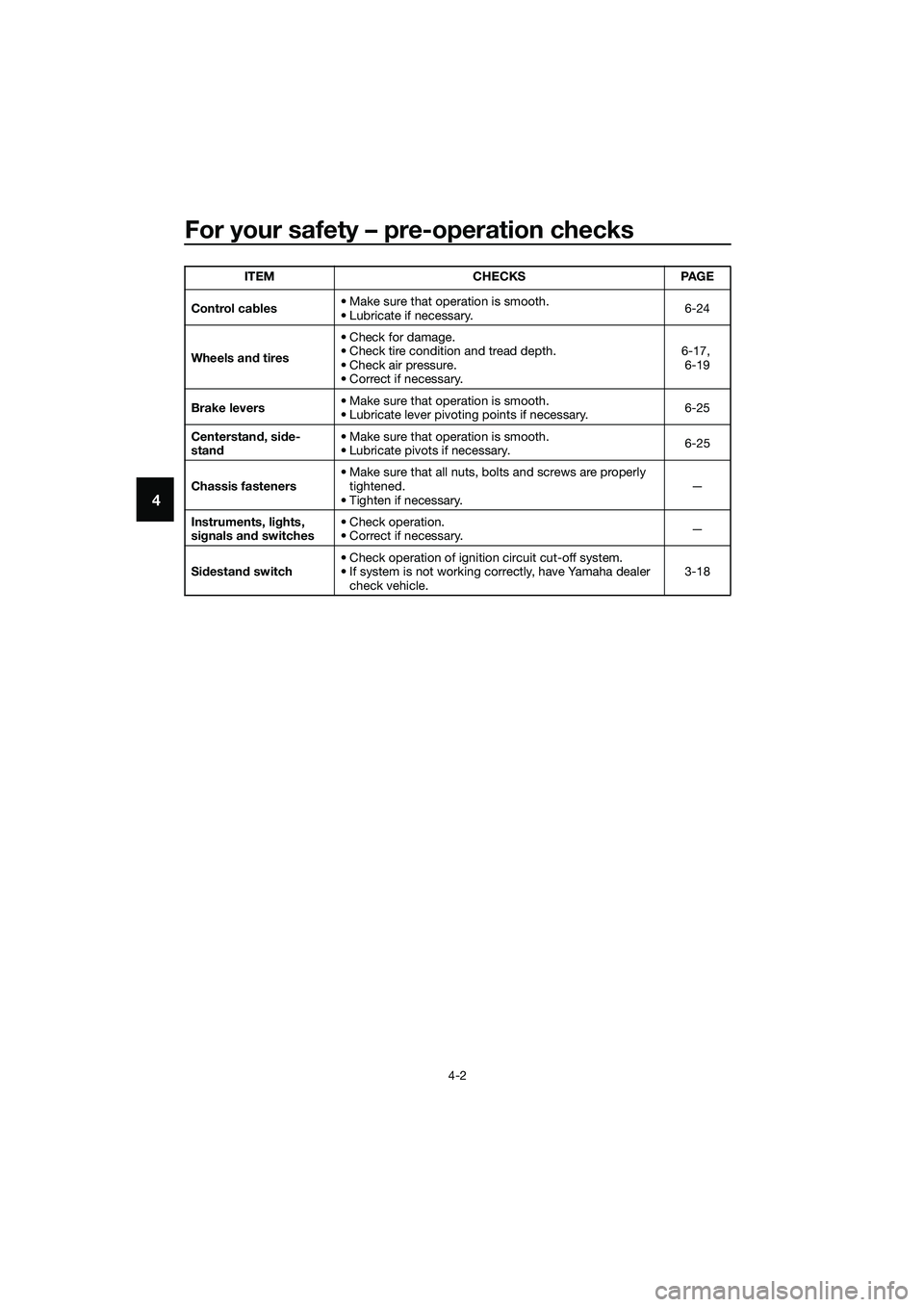
For your safety – pre-operation checks
4-2
4
Control cables• Make sure that operation is smooth.
• Lubricate if necessary.6-24
Wheels and tires•Check for damage.
• Check tire condition and tread depth.
• Check air pressure.
• Correct if necessary.6-17,
6-19
Brake levers• Make sure that operation is smooth.
• Lubricate lever pivoting points if necessary.6-25
Centerstand, side-
stand• Make sure that operation is smooth.
• Lubricate pivots if necessary.6-25
Chassis fasteners• Make sure that all nuts, bolts and screws are properly
tightened.
• Tighten if necessary.—
Instruments, lights,
signals and switches• Check operation.
• Correct if necessary.—
Sidestand switch • Check operation of ignition circuit cut-off system.
• If system is not working correctly, have Yamaha dealer
check vehicle.3-18 ITEM CHECKS PAGE
UBR7E0E0.book Page 2 Tuesday, October 25, 2016 2:44 PM
Page 49 of 92
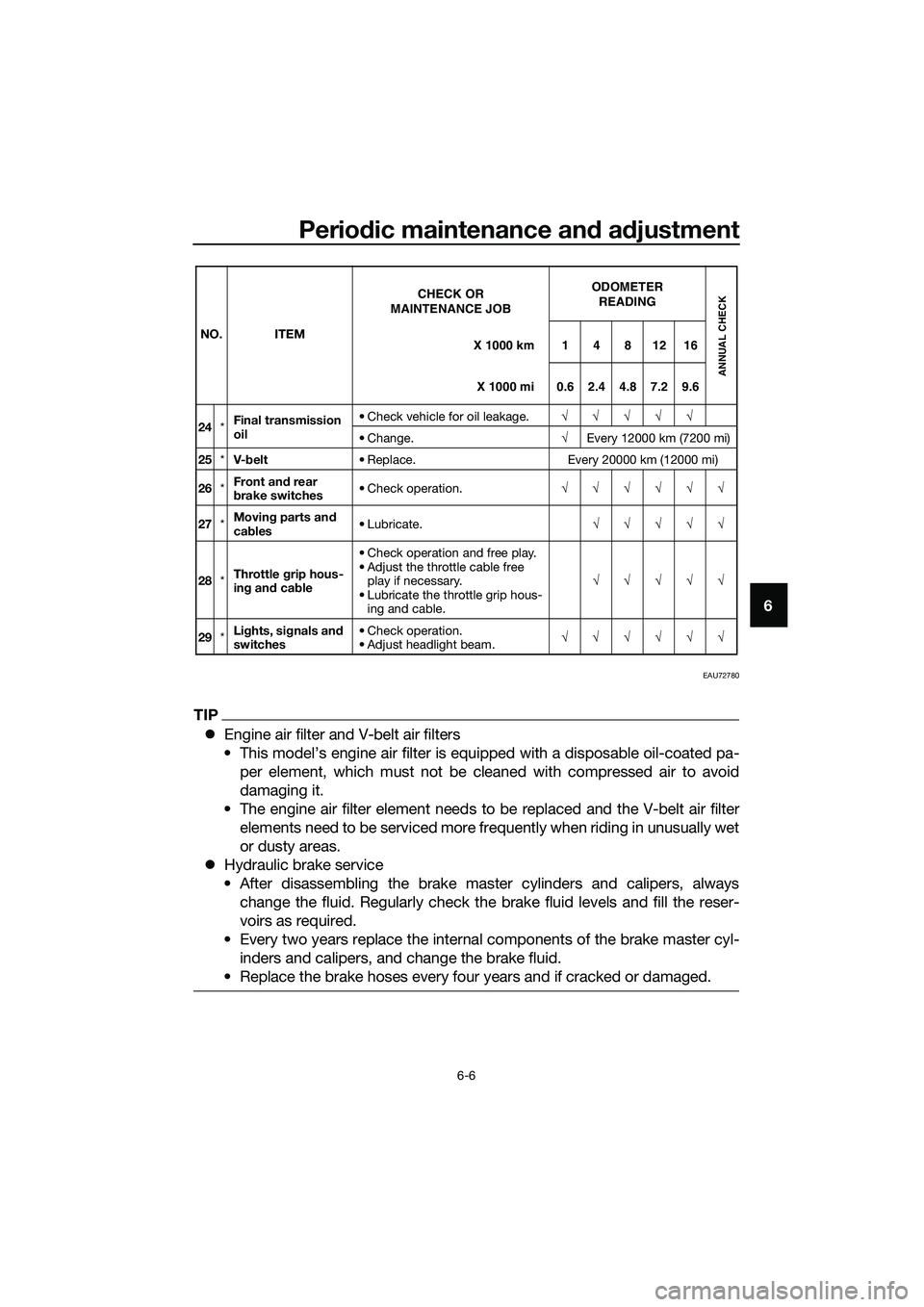
Periodic maintenance and adjustment
6-6
6
EAU72780
TIP
�zEngine air filter and V-belt air filters
• This model’s engine air filter is equipped with a disposable oil-coated pa-
per element, which must not be cleaned with compressed air to avoid
damaging it.
• The engine air filter element needs to be replaced and the V-belt air filter
elements need to be serviced more frequently when riding in unusually wet
or dusty areas.
�zHydraulic brake service
• After disassembling the brake master cylinders and calipers, always
change the fluid. Regularly check the brake fluid levels and fill the reser-
voirs as required.
• Every two years replace the internal components of the brake master cyl-
inders and calipers, and change the brake fluid.
• Replace the brake hoses every four years and if cracked or damaged.
24*Final transmission
oil• Check vehicle for oil leakage.√√√√√
• Change.√Every 12000 km (7200 mi)
25*V-belt• Replace. Every 20000 km (12000 mi)
26*Front and rear
brake switches• Check operation.√√√√√√
27*Moving parts and
cables• Lubricate.√√√√√
28*Throttle grip hous-
ing and cable• Check operation and free play.
• Adjust the throttle cable free
play if necessary.
• Lubricate the throttle grip hous-
ing and cable.√√√√√
29*Lights, signals and
switches• Check operation.
• Adjust headlight beam.√√√√√√ NO. ITEM
X 1000 km CHECK OR
MAINTENANCE JOB
X 1000 mi
ODOMETER
READING
ANNUAL CHECK
1481216
0.62.44.87.29.6
UBR7E0E0.book Page 6 Tuesday, October 25, 2016 2:44 PM
Page 75 of 92
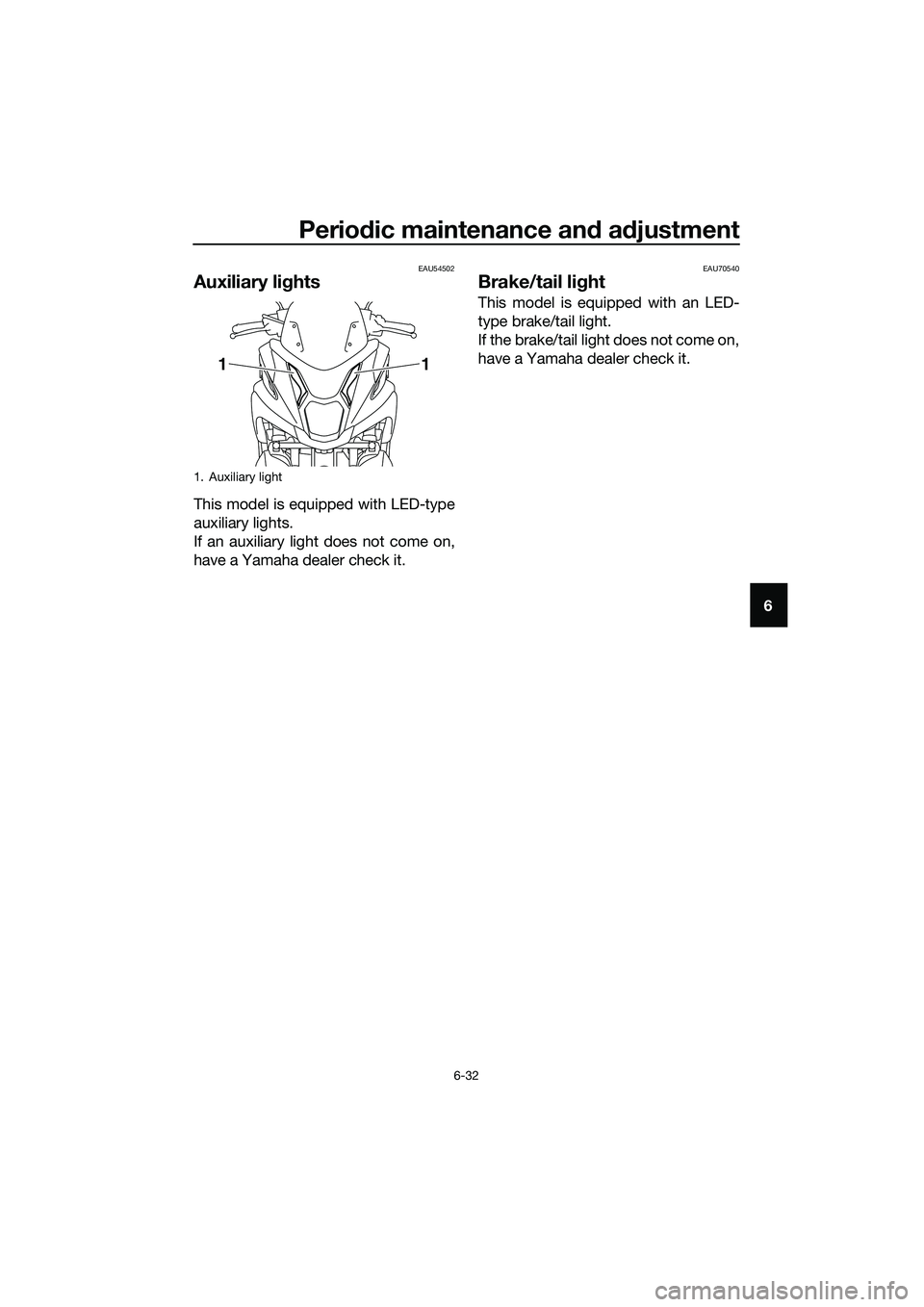
Periodic maintenance and adjustment
6-32
6
EAU54502
Auxiliary lights
This model is equipped with LED-type
auxiliary lights.
If an auxiliary light does not come on,
have a Yamaha dealer check it.
EAU70540
Brake/tail light
This model is equipped with an LED-
type brake/tail light.
If the brake/tail light does not come on,
have a Yamaha dealer check it.
1. Auxiliary light
11
UBR7E0E0.book Page 32 Tuesday, October 25, 2016 2:44 PM
Page 81 of 92
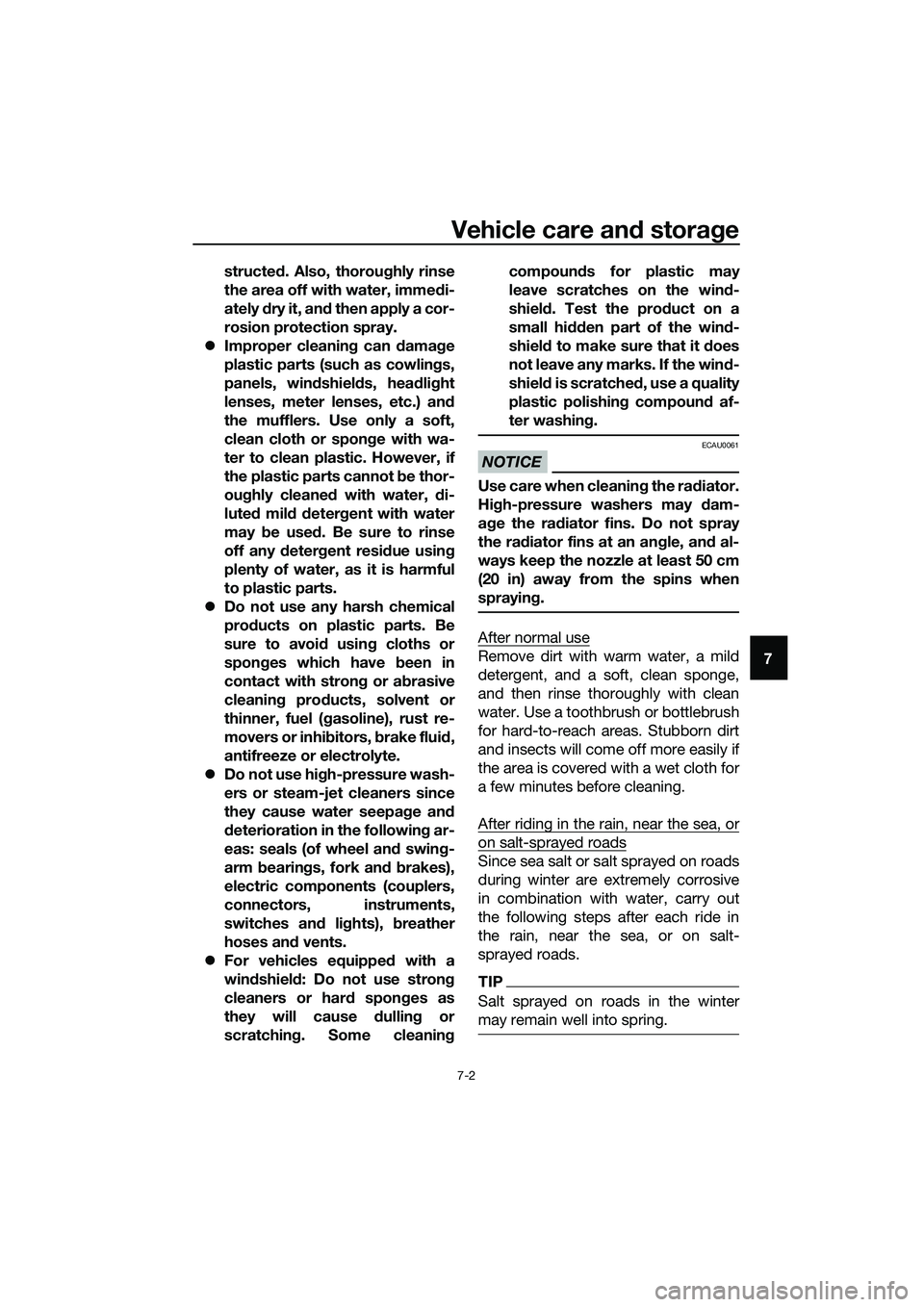
Vehicle care and storage
7-2
7 structed. Also, thoroughly rinse
the area off with water, immedi-
ately dry it, and then apply a cor-
rosion protection spray.
�zImproper cleaning can damage
plastic parts (such as cowlings,
panels, windshields, headlight
lenses, meter lenses, etc.) and
the mufflers. Use only a soft,
clean cloth or sponge with wa-
ter to clean plastic. However, if
the plastic parts cannot be thor-
oughly cleaned with water, di-
luted mild detergent with water
may be used. Be sure to rinse
off any detergent residue using
plenty of water, as it is harmful
to plastic parts.
�zDo not use any harsh chemical
products on plastic parts. Be
sure to avoid using cloths or
sponges which have been in
contact with strong or abrasive
cleaning products, solvent or
thinner, fuel (gasoline), rust re-
movers or inhibitors, brake fluid,
antifreeze or electrolyte.
�zDo not use high-pressure wash-
ers or steam-jet cleaners since
they cause water seepage and
deterioration in the following ar-
eas: seals (of wheel and swing-
arm bearings, fork and brakes),
electric components (couplers,
connectors, instruments,
switches and lights), breather
hoses and vents.
�zFor vehicles equipped with a
windshield: Do not use strong
cleaners or hard sponges as
they will cause dulling or
scratching. Some cleaningcompounds for plastic may
leave scratches on the wind-
shield. Test the product on a
small hidden part of the wind-
shield to make sure that it does
not leave any marks. If the wind-
shield is scratched, use a quality
plastic polishing compound
af-
ter washing.
NOTICE
ECAU0061
Use care when cleaning the radiator.
High-pressure washers may dam-
age the radiator fins. Do not spray
the radiator fins at an angle, and al-
ways keep the nozzle at least 50 cm
(20 in) away from the spins when
spraying.
After normal use
Remove dirt with warm water, a mild
detergent, and a soft, clean sponge,
and then rinse thoroughly with clean
water. Use a toothbrush or bottlebrush
for hard-to-reach areas. Stubborn dirt
and insects will come off more easily if
the area is covered with a wet cloth for
a few minutes before cleaning.
After riding in the rain, near the sea, or
on salt-sprayed roads
Since sea salt or salt sprayed on roads
during winter are extremely corrosive
in combination with water, carry out
the following steps after each ride in
the rain, near the sea, or on salt-
sprayed roads.
TIP
Salt sprayed on roads in the winter
may remain well into spring.
UBR7E0E0.book Page 2 Tuesday, October 25, 2016 2:44 PM